

7 Best Practices to Employ NLP for Contract Review






Contract agreements are believed to be the backbone of any business transaction. They represent a company's prior success, current commitments, and future opportunities. It's in a firm's best interest to create agreements that establish trust, mitigate risks, and enhance overall profitability.
Yet, handling large volumes of contract analysis and creation is one of organizations' most significant challenges. As per a study by Ernst & Young, 89% of organizations find managing high volumes of low-complexity contracts challenging. At the same time, 54% believe that it consumes their essential time that could be spent on other high-value tasks.
Research from World Commerce and Contracting suggests that the average cost of creating a contract with traditional practices is approximately $7000. Large organizations manage up to 350 contracts a week. Therefore, more and more organizations are planning to use automation to reduce the cost of contracting.
This is where automation technologies such as Natural Language Processing (NLP) emerge as game changers. Today, NLP is transforming the legal sphere by expediting the contract drafting and review process.
Below, we unveil the potential NLP holds with AI contract review and analysis while exploring its benefits, use cases, and implementation in contract review workflow. Let’s understand how intelligent AI supports legal teams in the contract management process.
NLP has emerged as a transformative force in contract analysis, revolutionizing how legal professionals navigate and interpret complex agreements. To grasp its impact, let's delve into the essence of NLP itself.
NLP is a part of artificial intelligence that allows machines to comprehend text and spoken language meaningfully and helpfully.
NLP is introducing significant transformations across numerous industries. But, it’s the legal realm where it has offered remarkable contributions, particularly with contract analysis.
Legal firms can automate and enhance their contract lifecycle by incorporating NLP in contract analysis from drafting and negotiation to execution and renewal. NLP can efficiently process and comprehend the intricate language used in legal documents, extracting critical information and identifying relevant clauses with unprecedented accuracy.
Leveraging NLP-driven tools, solicitors can save significant time and resources, minimize risks, and streamline contract processing.
NLP can process massive data sets from various sources like emails, social media, and reviews, giving businesses valuable insights. This empowers businesses to make informed decisions, helps enhance customer engagement, tailor their strategies to customer needs, and stay competitive in the ever-evolving market landscape.
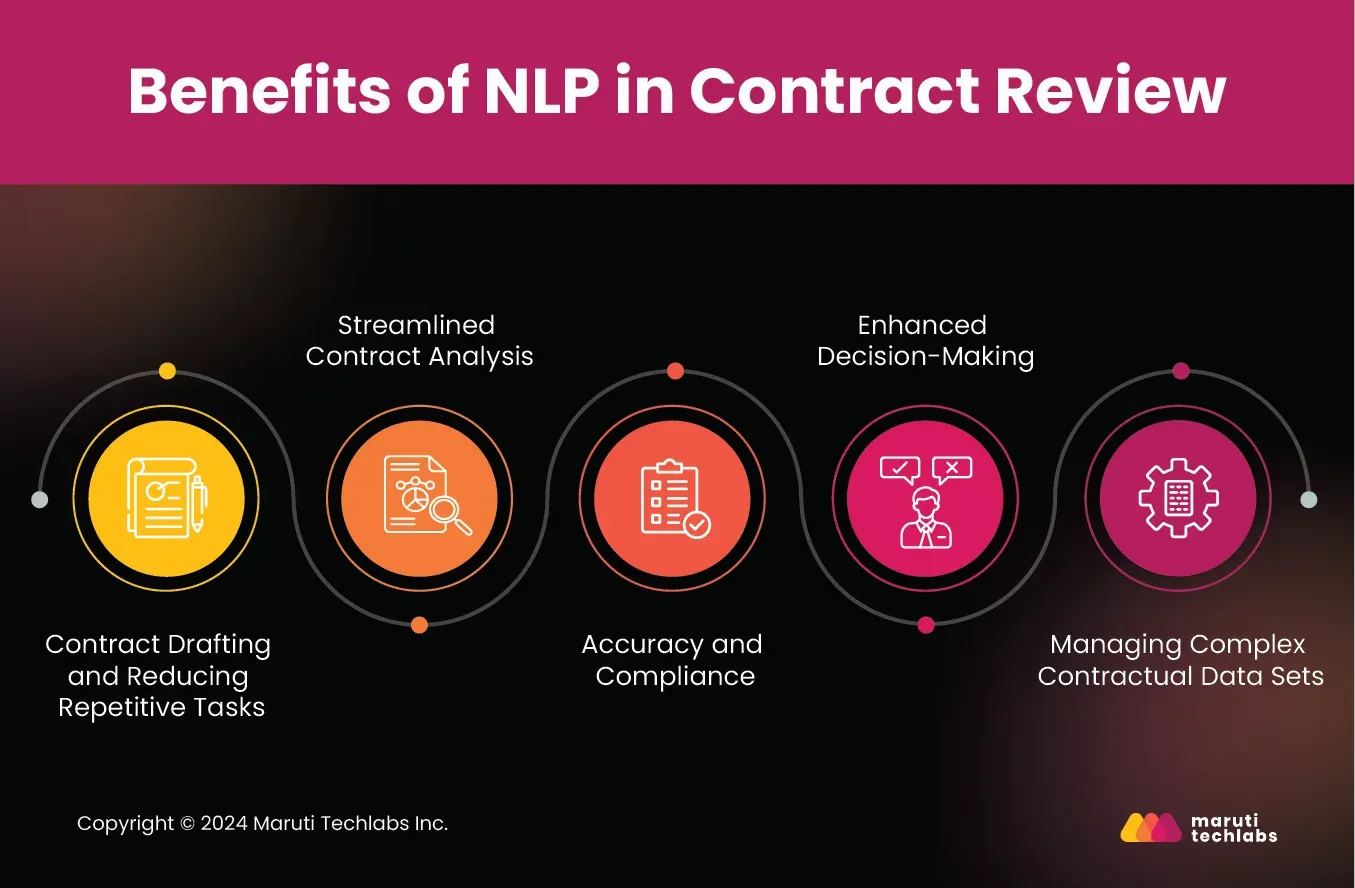
The use of NLP in contract analysis extends beyond the legal department, significantly benefiting other departments like finance and sales. Combining NLP with contract analysis aids risk management while increasing efficiency and effectiveness.
Additionally, it assists with drafting legal documents, identifying similar contract phrasing, summarizing legal clauses and data, and organizing data systematically based on clauses, ranges, and agreement terms.
Here’s a list of several advantages of employing AI-powered contract analysis.
NLP promotes coherent contract drafting by offering language suggestions and ensures document consistency. On average, it takes a lawyer 92 minutes to review a single contract as opposed to AI, which does it in 26 seconds.
With thousands of contracts to review, the human process is time-consuming and prone to oversight. Moreover, NLP in contract analysis accelerates document assembly while reducing production costs, ensuring thorough vetting of agreement terms.
SpotDraft is a legal technology startup that has created an AI-based contract management and drafting software. SoftDraft’s CEO and Co-founder, Shashank Bijapur, remarked that SpotDraft “enables law firms to do more for their clients in a shorter period of time.”
NLP tools can detect errors and discrepancies, automating the contract review process. An NLP tool can analyze contracts by adhering to your criteria and suggest corrective actions for clauses that don’t meet expected standards. It can also offer answers to open-ended queries.
NLP tools are trained to offer precision and compliance with legal standards. They reduce the possibility of errors while maintaining consistency concerning language and phrases across multiple contracts.
NLP-powered tools yield invaluable insights by scrutinizing contracts and retrieving structured data from contracts. These insights are fundamental to informed decision-making, allowing legal teams to comprehend contractual obligations, risks, and trends.
AI-driven contract management utilizes NLP to support efficient search and comprehension of legal terminology, preventing misinterpretations and saving time. The extracted data can readily be used due to the contextual analysis conducted in real-time, accelerating agreement analysis.
An NLP algorithm primarily retains knowledge by extracting knowledge from hundreds of thousands of contracts and applying insights from them to new agreements. This distinguishes them as the ultimate contract expert, eliminating biases and disputes over contracting authority.
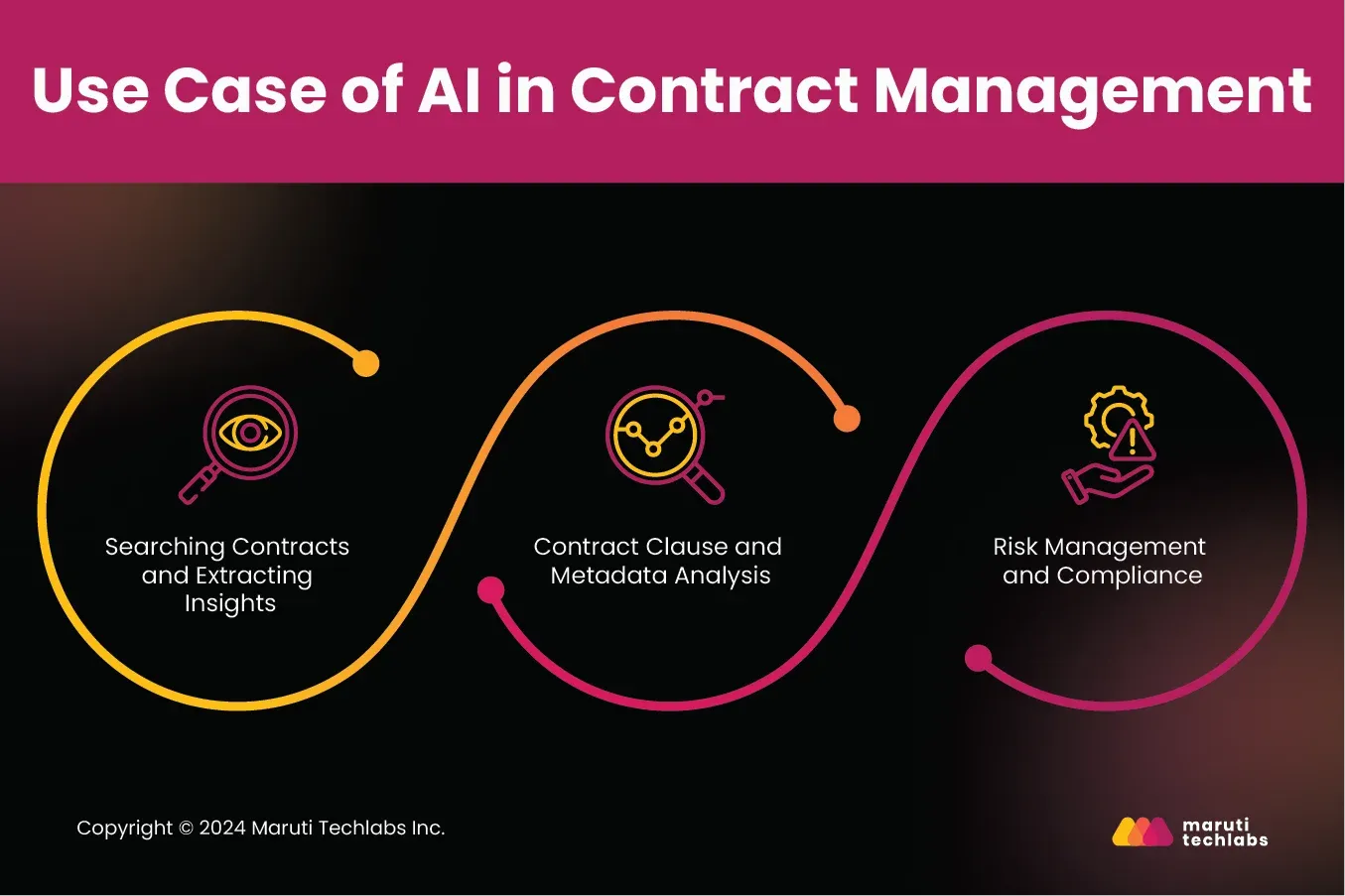
AI allows law firms to cater to intricate and disorganized contracting tasks, sparing time for pivotal elements like risk management and compliance. AI opens numerous avenues for integrating automation within many contract management workflows.
Here are a few use cases for AI-driven contract management.
Primarily, AI-powered contract management includes reviewing contracts at a large scale and clustering them based on numerous standard and custom metrics.
This encompasses searching and sorting legal contracts with similar terms or clauses, learning their impact on individual contracts, and affecting bulk modifications. A streamlined approach like this helps create contract clusters by determining specific metrics and KPIs while presenting contract anomalies and insights.
AI-fueled contract management involves grouping contract types and orienting them with current templates, learning crucial terms and metadata for distinguishing typical meta-information.
It incorporates training systems to understand custom metadata and scrutinize important clauses for classification, parsing, and mapping with present templates.
The terms and clauses should adhere to organizational processes suggesting fallback and alternative clauses. This is especially important for managing workflows across various stages.
Contract management with AI means extracting and categorizing obligations from numerous agreements into operational and financial segments. This incorporates accumulating and assessing myriad compliance and regulatory terms, conducting impact analysis with regulatory transitions, and ultimately assisting with risk mitigation.
Mikita Mikado, the co-founder of PandaDoc, commented, “In the realm of contract management, AI isn’t just a technology. It’s the catalyst for a revolution. AI streamlines and leverages every facet of the process, from contract creation to compliance. It’s not just about efficiency; it’s about empowering businesses to make smarter, data-driven decisions. AI transforms contracts into strategic assets, ensuring businesses stay agile, compliant, and competitive in an ever-evolving landscape”.
An advanced use of NLP contract analysis is interpreting clauses and subclauses in documents. By deciphering the context of the contract languages, an AI contract review software powered by NLP can identify numerous issues like vague terminology and time-critical provisions.
Below are ways in which NLP aids the contract review workflow, along with best practices for implementing NLP in this workflow.
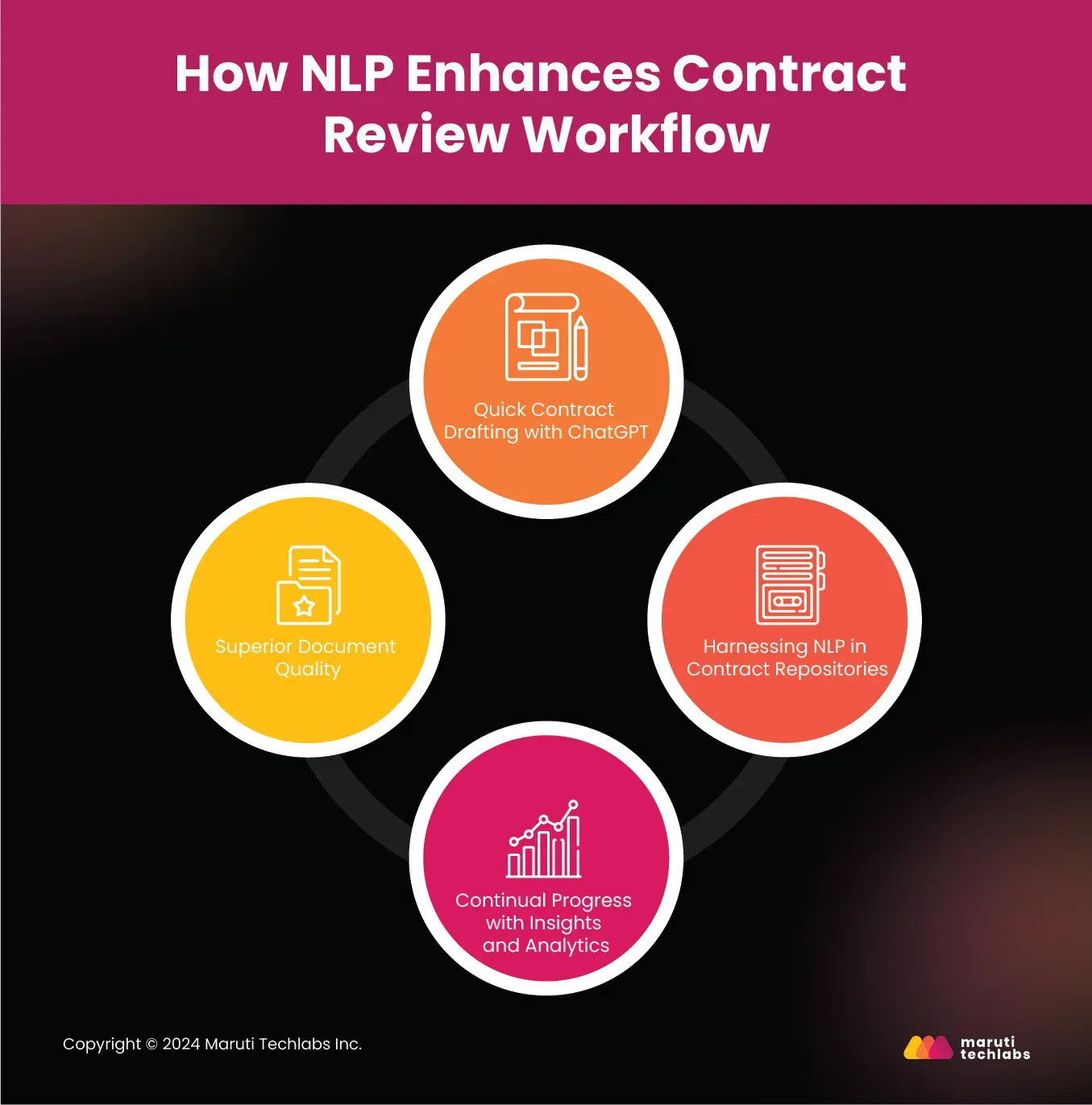
Strategically implementing NLP in contract management increases efficiency and shares insights for informed legal decision-making.
Here are a few tested ways to apply NLP in your contract review workflow.
One of the most adopted NLP-powered language models, ChatGPT, can revolutionize how contracts are drafted. Businesses can create rational and systematic first drafts by offering precise instructions.
This allows contract managers to focus on other crucial aspects of contract creation by saving time and resources.
NetApp, an intelligent data infrastructure company, faced a challenge with sponsorship agreements, as their contract review process took a lot of work. Hence, they decided to use LexCheck, an AI-powered contract review software.
After its deployment Connie Brenton, Vice President Law, Technology & Operations, NetApp, observed that “LexCheck eliminated an entire step of the process, reducing what took hours to a matter of minutes while also increasing the quality and consistency of the work.”
Also read: Technology in the Legal Profession: ChatGPT's Use Cases and Challenges
Efficient contract management can be conducted by keeping them organized and readily available. One can extract essential information, build user-friendly databases, and automate contract categorization using NLP-powered contract repositories.
This assists contract managers to make informed decisions by quickly retrieving their desired information.
Using NLP for contracts, litigators can also widen the scope to learn valuable insights into trends and user behavior. These analytical capabilities can then be leveraged to revamp negotiation strategies, learn areas of improvement, and refine areas of improvement.
Continuous improvement using NLP-powered contract management ensures processes remain agile and efficient.
“Our AI-driven contract management platform enables us to excel at looking into a contract and understanding what’s written on it. Once you understand that, you can automate a lot of functions both upstream and downstream,” says Shashank Bijapur, CEO and Co-Founder, SpotDraft.
Expensive legal documents can directly result from inaccurate or ambiguous contracts. NLP offers excellent assistance in showcasing errors, marking inconsistencies and ambiguities, and enhancing the overall quality of contracts.
This assures comprehensive and legally sound contract creation, preventing legal disputes during execution.
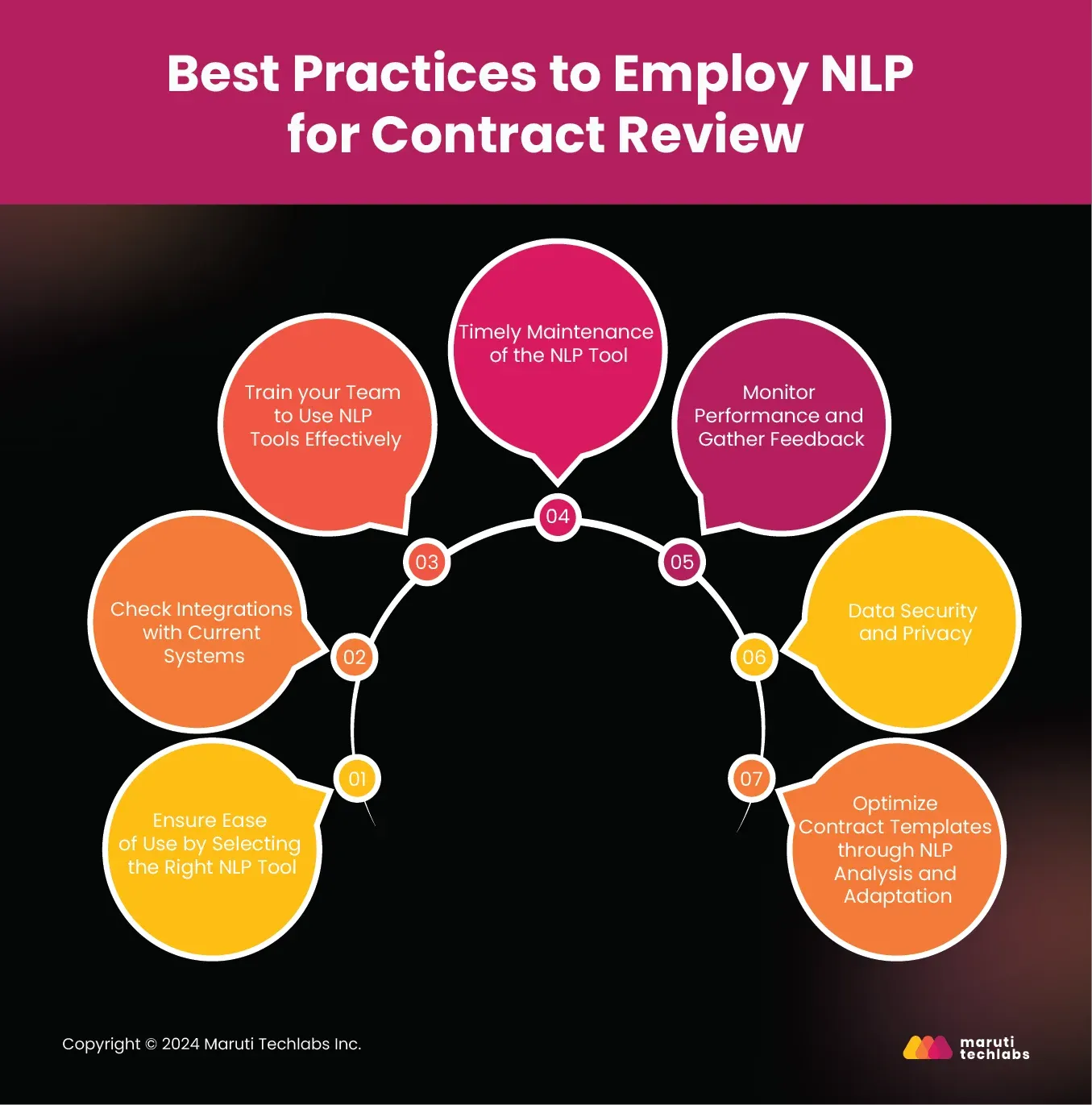
Here are the best practices to follow when employing NLP for contract review.
Choosing NLP tools that best cater to your organization’s needs is essential to reap maximum benefits. One must consider scalability, integration, and the types of contracts they handle.
Here are some pointers to consider for making an appropriate selection.
The key to maximizing efficiency is selecting tailored NLP solutions that integrate with your existing contract management processes.
Here are the key pointers to ensure integration.
Learning the limitations and capabilities of these tools is crucial. Therefore, training your legal and contract management team members is mandatory.
Below are some steps to ensure practical training.
Timely maintenance and upgrades are obligatory for accuracy and keeping your NLP updated with advancements in legal standards.
Here’s how you can attend this task.
To learn how to improve performance using your NLP tool, you must monitor its performance and collect feedback.
Consider these pointers while implementing this approach.
Contracts can contain sensitive information; privacy is paramount when using any tool.
Consider these guidelines to enhance security measures with your NLP tool.
Revamp your contract templates and strategies by employing insights from the NLP tool.
Take note of these tips when putting this into practice.
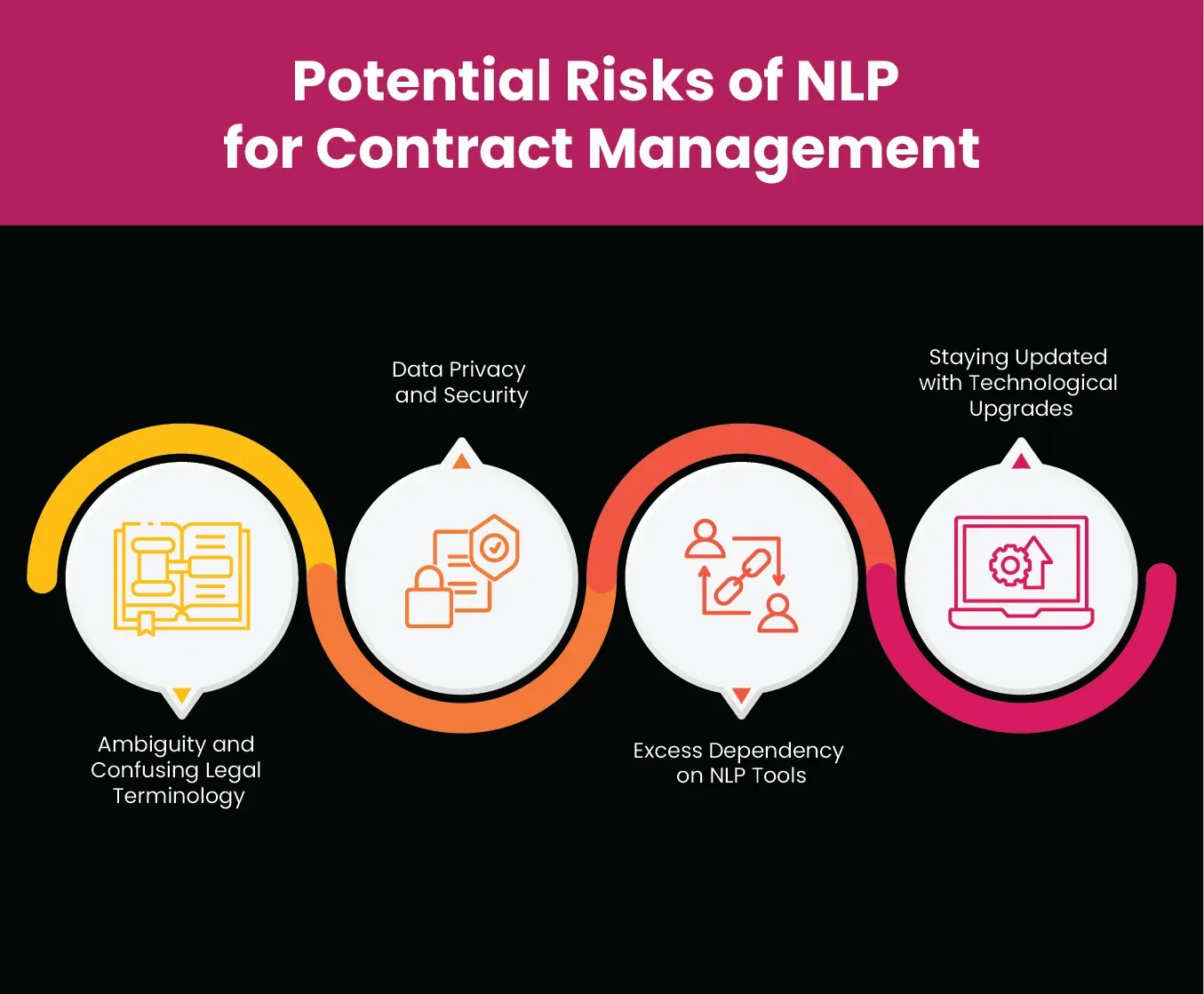
Though NLP does introduce transformative contract management solutions, one must address its intrinsic challenges and risks.
Here’s a list of the commonly overlooked challenges that accompany this transition.
NLP tools are designed for simple language processing. Therefore, convoluted terminology and vagueness can be a challenge.
Data privacy and security are legitimate concerns due to sensitive data when using tools. In today's time, when data breaches are persistent, tackling this challenge becomes crucial.
One can overlook critical nuances with their excess dependency on NLP tools. This oversight could result in misinterpretation.
AI technologies such as NLP are evolving too fast. Therefore, it’s necessary to stay updated with the latest developments. Your incapability to do so might result in outdated NLP systems.
Alternatives:
Contracts are imperative in today’s business landscape, and NLP has proven to be an essential ally. NLP offers excellent assistance with analyzing vast amounts of information and identifying key insights and critical nuances. This tech also facilitates improved decision-making, risk assessment, and compliance. With NLP, legal teams can concentrate more on other vital aspects of their work by streamlining the contract review process.
However, it’s essential to understand the subtle line between human expertise and technology, acknowledging that NLP tools don’t replace human prowess but rather complement it.
Future advancements in natural language processing promise more intuitive and innovative tools that will reshape legal tech for the better. The advances in this technology are anticipated to revolutionize contract analysis with increased precision in deciphering complex legal language.
In today’s day and age, embracing NLP tools isn’t just an option but a necessity for law practitioners to gain a competitive advantage over firms following traditional practices.
We at Maruti Techlabs have significant experience and expertise in crafting NLP solutions that are finely tuned to law firms' niche necessities. Our expertise is not limited to developing generic NLP applications but extends to devising solutions that foster contextual understanding in analyzing legal contracts.
Take the next step in your AI journey — try our AI Readiness Calculator to evaluate where you stand and how you can leverage AI for your legal operations.
Contact us today to explore how AI-powered NLP solutions can elevate your contract analysis processes.


